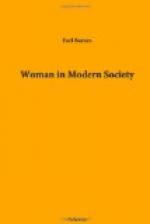[36] EARL BARNES, Children’s Ideals, in Studies in Education, Vol. II, p. 237; also School Girls’ Ideas of Women’s Occupations by SARAH YOUNG, in Studies in Education, Vol. II, p. 259.
The wealth and material comfort produced for the fortunate classes by these segregated industries have blinded us to their effects on human life, and we have all been bribed to silence concerning everything which could discourage enterprise or frighten capital. Like most bribes, however, these have largely stopped in the pockets of the exploiters of public opinion.
In the opening years of this new century, public consciousness has had a wonderful awakening.[37] The popular mind, quickened by universal education, and freed from a burden of fixed beliefs, is turning restlessly to inquire about everything that affects human life. Work could not escape this inquisition, and so we are asking not only for a fairer division of the profits of work, but we are also inquiring what occupations are unfit for women, with their special limitations and obligations. When the work is reasonable, how long should a woman work daily? Should she work at night and overtime? Should she work with dangerous machinery? Should she handle substances that endanger health? Should she be required to stand through hours of continuous work? Should she work in bad air, due to dust, moisture, or excessive heat or cold? Should she have a decent retiring-room? Some daring inquirers are even asking whether industrial efficiency, gained through specialization and keying up, may not be purchased at too high a price of mental monotony and nervous strain. Most people are content to learn that the effects are not immediately destructive to the girls and women involved; but some day we shall demand that the barons of industry shall not be allowed to squander the heritage of the unborn generations.
[37] C. HANFORD HENDERSON, Pay-Day, Boston: Houghton, Mifflin Co., 1911.
Women have themselves done much to quicken this public consciousness. Enrolled in labor unions, they have shown power to stand together and make sacrifice, as in the shirt-waist makers’ strike in New York in 1908, which commanded the admiration of all fair-minded observers. The more fortunately placed women have aided these movements toward self-betterment; and, through such organizations as the National Consumers’ League, they have compelled manufacturers and shopkeepers to observe more reasonable hours, pay better wages, and furnish decent material conditions for their employees.[38]
[38] See the recent volume, based on investigations made by the National Consumers’ League, Making Both Ends Meet, by SUE AINSLIE CLARK and EDITH WYATT, The Macmillan Co., 1911. See, also, Saleswomen in Mercantile Stores, by ELIZABETH BEARDSLEY BUTLER, published by the Charities Publication Committee, for the Russell Sage Foundation, 1912.




